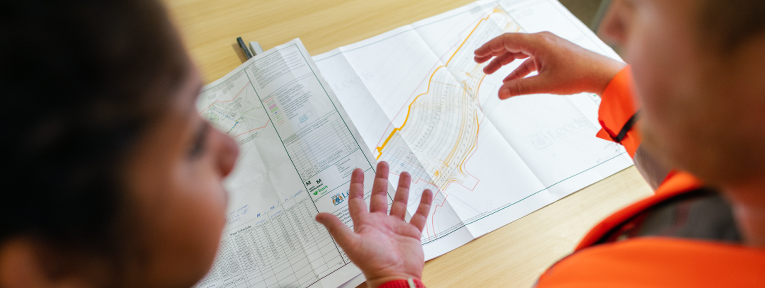
Dec 1, 2023 | News and insight, Tools
In a fast changing world, large organisations are increasingly engaged in projects and initiatives that are strategically critical. Such projects are likely to involve hundreds of people from different parts of the organisation working as cross-functional groups. The success or failure of such important initiatives is likely to be heavily influenced by the extent to which leaders and managers can motivated and organise these numerous groups to come together work as a single effective ‘Big team’.
A team of teams
There is an important distinction to be made between ‘big’ and ‘small’ teams. These simple words explain a much deeper concept. Terms like small and big are part of our basic language. They can therefore be seen to be generic, having a wide range of applications. In the context of teams, however, these two words have a precise technical role which helps establish some key differences.
The small team is the unit of production within any large enterprise. Emperors and generals have historically organised their armies and administrators into manageable groups. This is not however a top-down management strategy to create neatly arranged grouping on an ‘org chart’. It is actually a reflection of how humans prefer to work with each other. Groups of people naturally fall into sub-groups as the numbers involved start to increase. This is partly because we can typically maintain close engagement on a regular basis with up to ten people, but beyond that number, communication starts to become more sporadic and building close working relationships is more difficult. The point is that large teams do not exist as a single homogenous whole, shaped by a unitary corporate culture. Instead, a ‘Big Team’ is an organic collection of small groups whose roles and activities shift and change as the project they are engaged on progresses. Organisational success therefore depends upon the extent to which the leadership can enable this assembly of small teams to work effectively together as sub units which make up a single Big Team.
When working with leaders, we frequently hear the desire to create a high-performing team, but without having a clear idea as to what high performance actually entails. What constitutes performance is often subjective, depending upon the expectations of a particular team. When working with a collection of teams that make up a ‘Big’ team, however, performance must be articulated much more clearly so that there is a common understanding by everyone involved as to what is expected.
It is possible to map out a progression of activities that will enable the development of a high-performance environment which has the following features:
- Clear objectives fixed around sponsor and customer needs, giving the team a firm understanding of the desired outcome.
- Low hierarchy allowing direct connections between leadership and other specialist teams.
- Confidence in a low blame culture balanced with an expectation of high accountability.
- Fluid peer-to-peer networks where teams are encouraged to engage directly with one another to explore solutions.
- Strong behavioural norms which support a collaborative culture
Given the right environment, we have identified six primary elements that numerous practitioners have found to have a significant impact on the success or failure of a team engaged on a major project. They work in the following progression:
1. Shared Leadership
Big teams don’t necessarily need big leaders. All teams need some form of leadership but in Big teams, the ability of a number of individuals to take on the various aspects of leadership at various stages is critical to success.
2. Establishing the right project culture
One of the critical elements of success is to build a culture of alignment, but this cannot be mandated. Instead, the leadership team must create the right conditions to allow the desired project culture to emerge and mature.
3. Build alignment
Big teams must be able to focus on the right direction of travel even if they are not yet clear on the exact route. There are a series of practical activities that should be mandated as part of the set-up phase for each team and sub-team the is to be part of a major project. These include setting a clear vision, articulating core values, building interpersonal relationships with other teams, and agreeing a set of common rules for communication
4. Accelerated learning
Fast learning habits allow the teams to explore and experiment moving forward in short bursts of activity and adjusting plans as they go. The team is, in effect, learning how to learn. In a fast-changing environment, however, they may not adjust quickly enough to the new conditions and performance or output is likely to decline.
5. Maintain engagement
Leaders cannot force their followers to be engaged. All they can do is to create the right environment and anticipate the team will find their own drive and motivation. The core engagement activity is around communication and the use of an aligning narrative that informs and influences the messages and stories the teams use to understand what is happening in the wider organisation.
6. Build team resilience
In any complex and volatile environment, individuals and teams will find themselves in prolonged periods of pressure and stress. Team resilience differs from individual resilience in that given the right preparation, team members can learn to support each other so that they work together through periods of difficulty.
Summary
Teamwork is a fascinating and multifaceted subject. The contents of this article have hopefully given you a glimpse of the concepts, processes and structures for setting up a Big Team to give it the best opportunity to succeed. The component parts of leadership, culture, team set-up and team engagement are familiar to anyone who has frequent involvement in major projects. The framework is nevertheless novel in so far as it places the human components at the centre of business planning where as common management practice allows them to drift to the periphery.
There are, however, few shortcuts in the process. Building an effective team requires an investment in time and energy, both in the planning and implementation. The reward for this investment can be significant, improving the chances of bringing the project to a successful conclusion, on time and on budget. We would encourage any leader likely to have an involvement in a complex project to make the effort to move beyond standard practice and take the necessary steps required to build an effective Big Team.

Mar 28, 2023 | Tools
Projects often start with positive intentions, especially if you hold a good kick-off workshop which generates lots of ideas and action plans, and the team leave the event feeling energised and hopeful. Pretty soon, however, the reality of delivery kicks in and all the plans that would have embedded collaborative ways of working drift to the periphery of the agenda. So how do you keep the momentum going after the initial workshop is over? The best mechanism we have found is to establish a collaboration workstream.
A workstream is essentially a cluster of tasks that need to be completed to achieve a particular outcome within the project. The point of the collaboration workstream is to follow up on the actions and initiatives that the leadership team know are important, but are often otherwise displaced by the urgent issues that typically dominate their agenda. To give an example, the following list of questions emerged from the output of a recent project kick-off workshop:
- How do we establish a culture of ‘collaborative delivery’ throughout the project so that everyone understands the positive behaviours?
- What are the teams’ non-financial objectives and what are activities that will support their achievement?
- What actions are needed to develop a well-considered Relationship Management Plan?
- How does the project leadership monitor and measure the relationships between the key parties involved?
- How do we establish a communication strategy that emphasises the underlying narratives that will support a collaborative culture?
- What is the collaborative maturity of the teams and what training is needed to improve their collaborative skills?
- Where are the potential areas of disagreement/dispute that potentially lie ahead and how do we prepare the teams to avoid or resolve them?
- How do we define collaborative ways of working and how do we communicate them to everyone working on the project?
Each of these questions is a component of the overall delivery strategy that will require different levels of attention throughout the project lifecycle. As you can see, there is a lot to do, and so the tasks that arise from the discussion need to be resourced, organised and managed. It, therefore, makes sense to form a ‘Collaboration Workstream Steering Group’ that meets at regular intervals to oversee the progress. We recommend that the membership of the group should be no more than 5 to 6 people. Within this group, there must be a senior project manager or leader and ideally a collaborative specialist. The remainder of the group should be selected from individuals senior enough to ensure decisions are acted upon.
The other critical success factor is to identify and set up metrics that are reported to the project leadership team regularly. Collaborative metrics might include:
- Culture of trust and openness
- Clarity of delivery strategy
- Alignment of teams to the common goal
- Effective communication
- Effective meetings
- Information sharing
- One team ethos
Throughout the programme, one would expect to see these metrics move positively and negatively depending upon periods of pressure. We have found that reporting the trends regularly keeps the people element of the programme higher up on the leadership team agenda, prompting actions that can then be managed by the ’Collaboration Steering Group.
Collaborative delivery is as much a philosophy as it is a series of activities, but to be effective it must sit at the heart of a project or programme. By establishing a collaboration workstream, the management team is creating the facility to ensure the behaviours needed to achieve success are embedded into the team’s culture.

Aug 15, 2022 | Tools
Purpose: Tap into your team’s potential to solve complex problems
Time required: Initial half-day workshop, then interim follow-up work over the next six months
The theory behind the resource: The traditional approach to problem-solving on large projects is to rely on the knowledge and experience of individual experts. However, we are coming to realise that when faced with the often complex and ambiguous issues that are a feature of 21st-century, projects require a different way of thinking. The solution is to tap into the power of human ingenuity by using the collective thinking power of a diverse group. Teams can therefore provide an invaluable mechanism for finding new and effective solutions to difficult problems.
Accessing the collective intelligence of a team is, however, easier said than done. Assembling a group of bright minds does not mean they will generate any new thinking. There are a number of barriers which inhibit the truly open discussions that are needed. Miscommunication, a lack of appreciation of each other’s mental filters, outsized egos, and internal rivalries all diminish thinking capacity. To build collective intelligence, teams often need to learn, through training and group coaching, to be able to understand their limiting factors and how to work around them.
The process: The first step is to set up a half-day workshop, or to include the following activities as part of a team development day. The workshop comprises of three sessions.
Part One – Seeing different perspectives
The first part of the journey is to help team members recognise they have different ways of thinking. One of the fastest ways to do this is to use a simple psychometric that will help identify different motivations or preferences that will shape each person’s perspectives. Our preference is SDI (Strength Deployment Inventory) because it is quick to administer, easy to absorb, and most importantly easy to memorise. Having sent out the online tests the week before the team should arrive at the workshop aware of their own psychometric profile. The facilitator can then focus the team on the differences that are likely to emerge from each of the main profiles. The purpose of this first session is to engage the team members in a discussion that begins to help them see the potential value in having different perspectives when compared with the limitations that come with a single point of view.
Part Two – Formative experiences
How we behave in a working environment is also influenced by our previous experiences, both positive and negative. The second part of the workshop requires the team to split into groups of two or three people. Each person is then allowed five minutes to talk about what they remember as an important experience that has shaped how they think or make decisions. This could be personal or it could be professional. Once each person has had the chance to share, their counterpart must then provide a shortened (two minutes) summary of what they have heard, to the rest of the room. The value of this exercise is that it begins to deepen the types of conversation that can take place between team members helping them to understand what matters to each person and why.
Part Three – Understanding the need for psychological safety
A team is unlikely to harness its collective intelligence if some of the members do not feel psychologically safe. In other words, every person around the table feels sufficiently comfortable to be able to express their thoughts without fear of ridicule or retribution. This is easy to understand in theory, but how does it work in practice?
This is a short exercise where the concept of psychological safety is explained. Having allowed some time for questions, each team member is asked to spend five minutes thinking about the concept and to make a note of their thoughts around the following questions:
- When do I feel most safe in a meeting?
- When might I be uncomfortable?
- What could we do as a team to improve our sense of safety?
- How do we get better at challenging each other’s thinking without creating an intimidating atmosphere?
The facilitator then goes around the table, taking each of the questions, in turn, explains their thoughts without interruption, summarising their points on a flip chart. Once each person has spoken the team can then have a short discussion before moving on to the next point.
Part Four – Next actions
To close off the session, the team should spend 10 minutes identifying a series of actions they will take forward in future meetings.
Notes:
These exercises will not in themselves automatically improve the team’s Collective Intelligence. They will however your team the foundation upon which to build a more effective way of thinking as a genuine team. The key point to emphasise is that in a complex environment, there are few simple answers. Indeed one of the dangers teams face is to try and oversimplify an issue by simply ignoring the other elements that create complexity.
Part of the underlying learning from the above exercises should be that no single member of the team has the full answer, but each member of a team potentially has a part of it. Teams who can learn the humility to accept this have a much better chance of finding novel and practical responses to the challenges of 21st-century problems.

Apr 21, 2022 | Tools
Major projects are typically fraught with issues and problems. Teams are generally set up with the resources to solve day to day difficulties. It is why most of us like working on projects. What happens, however, when you have to rely on another team to find the answer? This is why every project needs to pay attention to the development of collaborative interfaces.
More often than not when we talk about collaboration we think of it as some form of generic process or activity that should be taking place across the whole of a project at all times. The reality is that collaboration is only needed when a problem occurs at the interface between two or more teams engaged in the delivery process. One of the key leadership activities sitting under the collaboration workstream should focus on the potential points of inter-team friction.
Here are some suggestions to consider that will improve collaboration by reducing friction:
1) Create an Interface Management Plan
Each team within a project should invest time in developing an ‘interface management plan’. This is a simple document that captures the thinking around the following questions
a. Who are we going to be dependent on to deliver our portion of the works
b. Who is going to be dependent on us
c. What are the potential friction points where problems could arise
d. Who are the individuals we need to get to know in those teams where we have a degree on interdependency
e. How should we connect and communicate with them to establish the right relationships? The development of the plan should be treated as a short and simple exercise, the output from which is contained in a single sheet of paper. It can be created in a couple of hours, but should be a team exercise so that everyone is aware of the need to manage the interfaces.
2) Build collaborative relationships
If you know you are going to need help from someone in another team, it is a good idea to have some form of positive relationship with them. We advocate the process of building what is known as Level 2 relationships, where we seek to have the kind of social exchanges which enable us to learn enough about the other party to be able to see them as human beings rather than simply names attached to a role. Of course, people must be allowed to make their own choices about building personal relationships, but we can put in place mechanisms to stimulate our team’s knowledge of each other through meetings, workshops and social events.
3) Manage blame instinct
It is also helpful to train your teams to understand the counter-productive nature of blame when things go wrong. Blame is an emotional reaction to frustration and anger, but it tends to be highly destructive and usually closes down our ability to find solutions as we limit communication and establish adversarial positions. As human beings, we cannot control our emotions, but we can learn to manage them. So train your teams to understand the need to move quickly from a reactive response that the other team is at fault, to a reflective position where you try to understand what has gone wrong and how to remedy the situation.
Paying attention to collaborative interfaces can be thought of as another form of risk management. It requires identifying key interdependencies in advance and putting in place a plan of activities to mitigate the consequences of inter-team conflict. At ResoLex, we come across too many projects where the leadership takes a view that a proactive approach to collaborative relationships is unnecessary. This attitude is somewhat complacent as human beings have a tendency to react negatively when under pressure or stress. So paying some attention to establishing positive interfaces between the right people at the right time, will significantly improve the chances of a successful outcome.

Mar 4, 2022 | Tools
How many of the meetings that you attended in the last month had a focused and clear agenda, ran to time, and sought a useful contribution from each of the attendees? How many of those meetings had attendees who then agreed and noted down a set of actions? From the feedback we have collected from teams working on major projects, the answer probably is: ‘not many’. If one considers the huge amount of time and resource that goes into meetings, it is astonishing that project leaders and their commercial advisers do not put more effort into ensuring that meeting time is used effectively. Much has been written on this topic, but bad meetings continue to be a chronic problem in most project teams. So, what can be done to make a difference? I believe some effort should be applied to relearning the lost art of ‘chairing’… let’s take a further look.
The term “chairman” arose in the mid-17th century and was used to describe someone occupying the ‘chair of authority’ for a meeting, group, or corporate body; the person responsible for ensuring the effective outcome of the meeting. Over time, we seem to have interpreted that for the chair to hold authority, the role should always default to the most senior individual at the table, but this isn’t the case.
The prevailing assumption appears to be that chairing a meeting is simply a matter of being in charge, where seniority governs how contributions are made and should be received. We also face an interesting phenomenon that senior managers and leaders rarely think their own meetings are run badly, but can quickly identify the problems of poor leadership in meetings where they are only attendees. The suggestion that they might need to do some training in this area will often be swiftly dismissed, and so, organisations continue to propagate the habits and culture of bad meetings. Fortunately, there are some straightforward and easily applicable actions that leaders and attendees can follow to curb bad meeting culture, the question is, how?
The importance of effective meetings
People meeting in groups of four or more typically requires a degree of leadership to ensure the time spent is productive. To get the best out of any group event, people need a framework which that sets the expected boundaries of behaviour within which they can feel comfortable to express themselves and, be creative in their thinking, whilst engaging with the thoughts and ideas of others in the room.
For effective meetings, organisations need to adopt a framework and create a good meeting culture, this should be exampled by the project leaders and embraced by all team members.
A distinctive role
The Chair of a meeting should be seen by everyone as a distinct and essential role to having productive meetings. Defaulting to the most senior person is not necessarily the right option, especially, if they are needed as part of the discussion. The Chair needs to be able to take a step back from the content of the discussion and focus on using their skills to facilitate and keep the meeting on track – these distinct skills are not difficult to learn but are hugely important. Regardless of your seniority, you cannot assume that you have the right skills to chair a meeting – however, you can develop skills these skills and help your team have more effective meetings.

Chairing a better meeting
At a basic level, the primary skill for chairing a meeting is to learn to contract with the rest of the group. Contracting is a process used at the start to remind everyone of their shared purpose in attending the meeting. This is the most important part of the session as it provides everyone with the opportunity to become aligned with the required output of the meeting. The contracting process gains attendee consent to a short set of agreements at the start of the meeting which the Chair will use throughout to provide boundaries and to keep participants accountable. The agreements should align with the following:
- Reiterate purpose
The Chair should reiterate the purpose of the meeting and confirm agreement with the participants. Without an agreed purpose, it is easy for the discussion to be derailed by other urgent concerns. The Chair can use the agreed purpose to keep the meeting focused on what is important for that particular meeting.
- Agree on outputs
The Chair will agree on outputs with the attendees – they could be shared information, a technical solution or some initial thoughts and ideas, but there must be an agreement between those involved on the expected outputs from the meeting.
- Expected timings
The Chair should confirm timings with the group and offer an opportunity for anyone to communicate if they need to leave the meeting early.
- Common ground rules
People assembled as a group need a set of common ground rules within which to operate. When the ground rules are not explicitly stated, bad behaviours tend to creep in, and meetings become ineffective. The following ground rules should be stated by the Chair at the start of the meeting:
- Everyone present is expected to speak
- Everyone who speaks is allowed to be heard
- We have one conversation
- We stick to the topic
- Everyone stays present (no checking emails on your phone, etc.)
Everyone is then asked to state they agree. This might seem overly formal, but the point about these rules is that they create a verbal contract within the group which gives the Chair the authority to pull people back in line when they move off-topic, become disengaged or display other behaviours which may take the meeting off track.
- Taking notes
One of the most important roles in any meeting is to agree on who is going to take a formal set of notes. This is a particular problem in meetings among senior people, as note-taking is traditionally regarded as a task for junior staff and often ignored. The problem is, without some form of record of the discussion, it is very easy for each participant to walk out of the room with a different interpretation of what was agreed. As a bare minimum, the Chair should ensure a written note is circulated that summarises:
- The date;
- Who attended;
- The matter under discussion;
- Agreed actions by whom and by when.
Again, this may seem basic, but in a major project, hundreds of meetings take place every day, and if it is common practice to meet without formal notes, decisions often become blurred or misinterpreted.
Advanced chairing skills
Once the meeting is off to the right start, with everyone focused on the agenda, and following the ground rules there are, however, additional skills that can be very useful when dealing with ‘difficult’ meetings. These include:
- Identifying the introverted thinkers and ensuring they contribute
- Managing extroverted thinkers who continually interrupt others
- Reading the dynamics of the room to identify interrelationships and how they influence the discussion
- ‘Hearing’ what is not being said to identify issues people may be avoiding
- Managing outsized egos who want to push their own agenda
- Avoiding ambiguous decisions that allow different interpretations of what is being agreed
These are skills that aren’t essential at the beginning but are skills that every Chair should aspire to learn over time.
Final thoughts
What can we take away from this? Project leaders need to ensure that all meetings are effective – to do this, they need to make sure team members are aware of the specific framework needed for meetings and ensure that there is someone competent to take the role of Chair. The Chair must be trained in the various skills mentioned above in order for them to facilitate the meeting well. These behavioural changes will help teams focus on the topic at hand and use their meeting time effectively.
As a final thought, consider how many meetings you will be involved in across your project this week – perhaps you are taking the role of chair for several of them. How might you adopt a structured approach to chairing these meetings and what would the effect be on the productivity of your time and others in your team?

Nov 24, 2021 | Tools
ResoLex is an independent consultancy specialising in collaborative working, risk monitoring, and stakeholder engagement. We see projects comprising of three primary areas of expertise; technical, commercial, and social. The social element is often ignored by project leaders or allowed to drift to the periphery of project activity. We work with project teams across several industries, using a combination of behavioural theory, technology, and industry experience to co-create new solutions that help them work better together – resulting in more efficient and sustainable projects.
In December 2020, the Government released ‘The Construction Playbook’ in a bid to transform how major projects and programmes are assessed, procured, and delivered. This is part of a wider goal to make construction a world-class sector by improving productivity, providing jobs, and achieving net-zero greenhouse gas emissions by 2050. Based on our research into team performance and our experiences in supporting teams engaged in the design and construction process, we released ‘Changing Behaviours in Construction: A complement to the Construction Playbook’. The report is intended to act as a supplement to the Construction Playbook, providing those tasked with implementing the new procedures with some practical advice on how to create and then lead strong project teams.
For Digital Construction Week 2021 our Consultant, Kelachi Amadi-Echendu and Associate, Karen Fugle (also Executive Coach at SleepingGiant Consulting) will be highlighting our ‘Top Five Suggestions for Improving Project Performance through Collaborative Behaviours’ in the ‘People & Change’ theatre at 4pm on day two, the 25th of November.
 The full details can be found on the Digital Construction Week website here.
The full details can be found on the Digital Construction Week website here.
As a teaser, here are the areas we will be discussing during the talk that will help provide you and your teams with practical guidance and tools that can be applied to the industry challenges highlighted throughout.
- Front-end loading
- Selecting the right Team Leaders
- Measuring cultural development
- Aligning to a common goal
- Adjusting the mindset of conflict avoidance
If you’re intrigued, pop along to our talk or email us ([email protected]) to arrange a chat on the day. We look forward to seeing you at Digital Construction Week! For more information on our services please visit our website: www.resolex.com.







